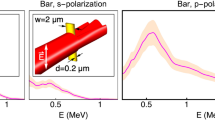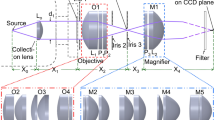Abstract
FOR some years it has been possible to focus beams of electrons into fine probes with diameters in the range 10 µm–100 Å. These have been used for electron beam machining, electron probe analysis and scanning electron microscopy. Progress in focusing ion beams has been more limited. Notably, Gabbay et al.1 have used a beam of lithium ions from a coated tungsten hair-pin filament and have reported a resolution of the order of 3 µm in a scanning ion microscope. The only work in which very fine beams of rare gas ions have been used appears to be that of Saparin et al.2, who have reported a final beam diameter of 10–15 µm at 30 kV. von Ardenne3 has described two systems, one using a canal-ray source and the other a capillary source in which ions were focused to about 5 µm, but in this case the final lens used was of very short focal length and the focus was not readily accessible.
This is a preview of subscription content, access via your institution
Access options
Subscribe to this journal
Receive 51 print issues and online access
$199.00 per year
only $3.90 per issue
Buy this article
- Purchase on Springer Link
- Instant access to full article PDF
Prices may be subject to local taxes which are calculated during checkout
Similar content being viewed by others
References
Gabbay, M., Goutte, R., Guilland, C., and Monllor, C., C.R. Acad. Sci., 261, 3325 (1965).
Saparin, G. V., Spivac, G. V., and Stepanov, S. S., Proc. Sixth Intern. Conf. Electron Microscopy, Kyoto, Japan, 609 (1966).
von Ardenne, M., Z. Tech. Phys., 20, 344 (1939).
Beske, H. E., Z. Angew. Phys., 14, 30 (1962).
Smith, A. J., Cambey, L. A., and Marshall, D. J., J. App. Phys., 34, 2489 (1963).
Liebl, H. B., and Herzog, R. F. K., J. App. Phys., 34, 2893 (1963).
Smith, A. J., Marshall, D. J., Cambey, L. A., and Michael, E. J., Vacuum, 14, 263 (1964).
Poschenreider, W. P., Herzog, R. F. K., and Barrington, A. E., Geoehim. Cosmochim. Acta, 29, 1193 (1965).
Kanaya, K., Kawakatsu, H., Matsui, S., Yamazaki, H., Okazaki, I., and Tanaka, K., Optik, 21, 399 (1964).
Long, J. V. P., Brit. J. App. Phys., 16, 1277 (1965).
von Ardenne, M., Tabellen zur Angewandten Physik., 1 (1962).
Moak, C. D., Banta, H. E., Thurston, J. N., Johnson, J. W., and King, R. F., Rev. Sci. Instrum., 30, 694 (1959).
Kaminsky, M., in Atomic and Ionic Impact Phenomena on Metal Surfaces (Springer-Verlag, 1965).
Everhart, T. E., and Thornley, R. F. M., J. Sci. Instrum., 37, 246 (1960).
Almén, O., and Bruce, G., Nuclear Instrum. and Methods, 11, 257 (1961).
Author information
Authors and Affiliations
Rights and permissions
About this article
Cite this article
DRUMMOND, I., LONG, J. Scanning Ion Microscopy and Ion Beam Micro-machining. Nature 215, 950–952 (1967). https://doi.org/10.1038/215950a0
Received:
Issue Date:
DOI: https://doi.org/10.1038/215950a0
This article is cited by
-
Uses of Fine Focused Ion Beams with High Current Density
Nature (1968)
Comments
By submitting a comment you agree to abide by our Terms and Community Guidelines. If you find something abusive or that does not comply with our terms or guidelines please flag it as inappropriate.



